Fitting guttering
When fitting guttering, base decisions on which way a run will flow according to the position of gullies and drains, because this is where the downpipes must be directed. Some downpipes will terminate above ground and others underground, so take this into account when deciding whether you need a downpipe shoe at the bottom, or just to let the pipe run directly into the drain. Guttering can be made from different materials, but you will find it most commonly made from UPVC. This type of guttering is lightweight, straightforward to fit and requires little maintenance. The sequence below shows how to fit UPVC guttering, although the same principles can be applied to fitting other guttering types.
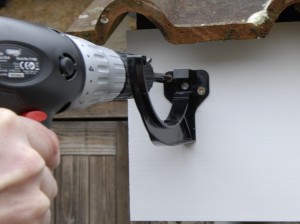 |
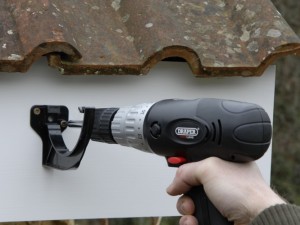 |
| 1. Fix the first support clip high up on the fascia board, under the roof covering, at the opposite end from where the running outlet will be. |
2. Secure a second clip at the other end of the gutter run, lower down than the first clip, next to where the running outlet will be positioned. |
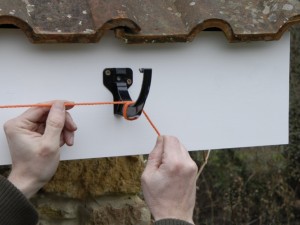 |
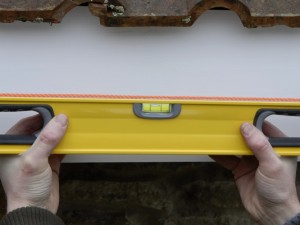 |
| 3. With both clips in place, tie off a length of string between the secured clips. The line should be pulled taut between the two clips. |
4. Check that the line is running downhill. Hold a spirit level against the taut line and check to see that the bubble is slightly off centre. |
 |
| 5. With the first two support clips in place, you are now able to fix further clips at 1m intervals between them. On a long run, where gutter lengths will require joining, you will need to fit union brackets along with the standard support clips. In this way a watertight joint can be made where needed, while at the same time ensuring that the longer lengths are adequately supported from one end to the other. |
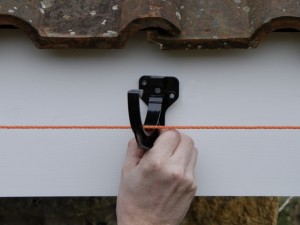 |
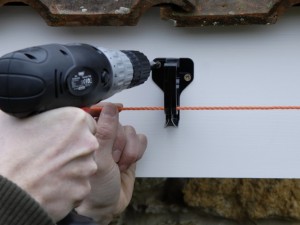 |
| 6. Position the second clip 1m from the first clip, ensuring that the string line is just touching the internal edge of the clip, as shown. |
7. Fix the clip in place. Make sure that it is vertical and double-check that the string line just touches the bottom of the inner edge of the clip. |
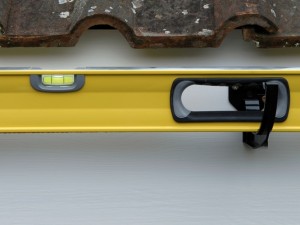 |
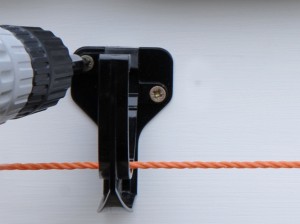 |
| 8. If you have a long spirit level, you can lay it between clips as another way of making sure you are maintaining the slight downhill gradient. |
9. Continue on to the next clip, another metre further down the gutter run. Repeat the fixing procedure until clips are positioned all the way across. |
 |
| 10. With the clips in position, you can now move on to fitting the guttering. Measure the full length of the proposed gutter run and mark off on a section of guttering. Fit the running outlet next to the lowest clip. Take note of the guideline marks inside the running outlet to show where the gutter end should finish. At the other end, in this case the edge of the roof itself, allow enough length so that the tile overhang is accommodated. |
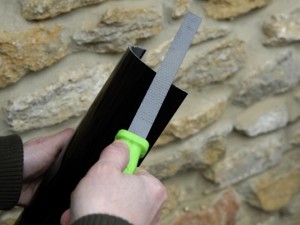 |
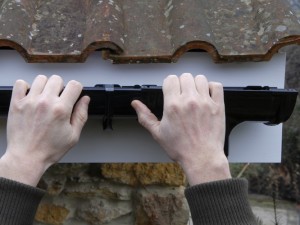 |
| 11. UPVC guttering may be cut with a hacksaw or panel saw. File any rough edges on the cut ends to make sure it is perfectly smooth. |
12. Simply clip the lengths in place inside the support clips and running outlet. Fit a stop end on the open end of the run. If too long, trim and reposition. |
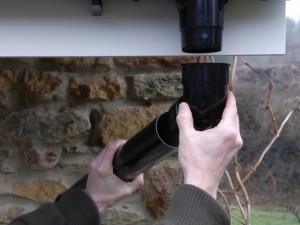 |
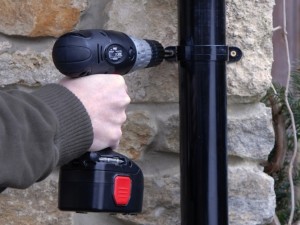 |
| 13. At the running outlet, use offset bends to direct the downpipe towards the wall above the gulley or drain – the place where the water will run away. |
14. Cut the downpipe to length. Fix clips at the top, bottom and at 2m intervals in between. Use a downpipe shoe at the base of the pipe if required. |
 |
| 15. With the gutter run complete, be sure to test the flow of the water by pouring a bucket of water in at the high end. The water should drain easily down to the running outlet and into the downpipe. If a union bracket has been included in the run, check whether this leaks or not. If it does, unclip it, make sure that the rubber gaskets are positioned correctly and reassemble. Consider fitting a leaf guard over the outlet to help prevent blockages. |
Further guttering advice
- When working on guttering, safety is the first concern. Gutter work should ideally be carried out from fixed scaffolding.
- Guttering is supplied in standard lengths, normally 2, 3 or 4m. On a long run where lengths require joining, use union brackets. These wide support clips with rubber gaskets create a watertight joint.
- Gutter profiles are commonly half-round in section, but other profiles are available, which are squarer or more ornate in section.
- A gutter run must slope slightly so that water will efficiently to the downpipes. The gradient required to maintain the flow is 1:600 or 1cm in every 6m.
- Blocked downpipes often result from a build up of leaves and debris finding its way into the drainage system. Consider fitting leaf guards to prevent this from happening.
Tags: garden, guttering, plumbing basics, waterproof
This entry was posted
on Tuesday, October 4th, 2011 at 2:29 pm and is filed under 'How-to' Guides, General Plumbing.
You can follow any responses to this entry through the RSS 2.0 feed.
You can leave a response, or trackback from your own site.
















I have installed a wetroom ,can i run the waste water into the gutter downpipe .Advice would be very welcoming
Hi Albert,
The answer is almost certainly no I’m afraid. Rainwater is normally kept separate from waste water as the rainwater should either be going into a soakaway or drain direct into local rivers etc. Waste water will drain into a sewer that goes to a sewerage treatment plant. Running waste water into rainwater pipes is therefore a pollution risk. Having said this, some older houses have a system where both rainwater and waste water enter a combined sewer, so both types of water go for treatment at the sewerage treatment plant. If you fall into this category, it may be possible to do as you are asking, and fit a hopper along the downpipe, and allow the waste pipe from your wet room to drain into this. However, I would advise you to make a quick call to your water supplier to check this is okay, as you’d definitely be breaking the law if you don’t have a combined sewer, or the downpipe is simply draining into a soakaway.
Hope this helps,
Best,
Julian
Thankyou Julian for not only for your advice ,but also for giving me piece of mind .i have a detached bungalow which does have the rain water running into the waste water system .Thankyou again Albert
Hi Albert,
Glad to help, and as long as you’re sure you have a combined sewer, it sounds like you should be okay……but being devil’s advocate, are you sure that the downpipe you are talking about, is in itself ‘legal’ as there’s nothing to say that it could have been incorrectly positioned to feed into your waste system. Sorry to put a bit of doubt in your mind, but I’d rather be safe than sorry. If you’re not comfortable with calling your local water services company, you could perhaps check on the ‘search’ documents you would have had when you bought the house – these may confirm water/sewerage pipe routes etc. I may be being overcautious here, and you’re certain you have a combined system, but I just wanted to check that just because it may look like a combined system, doesn’t mean it is. Therefore a little further checking may be needed, to be sure.
Best,
Julian